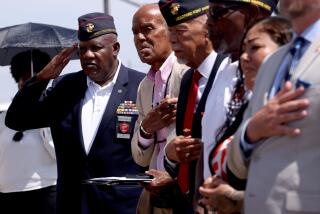A Better Way? He’ll Find It : Sierra Madre Mountaineer Rethinks His Rescue Gear
If you’ve recently helped carry a 200-pound victim with a broken leg down a narrow, rocky trail, you probably owe one to Russell Anderson.
Back in the days when being on a search-and-rescue team often meant tracking victims down in the wilderness, then using sheer muscle to haul them out, Anderson got to thinking. A longtime Sierra Madre Search & Rescue Team member, Anderson is fit but not particularly muscular, and he has a bad back. Hauling heavy loads in the mountains--that’s agony, he says.
“Hit a narrow spot in the trail, and only two guys can carry the litter,” says Anderson, 56, a slim, talkative man, with short gray hair cut into what he calls an “Ollie North.” “It took a couple of gorillas.”
Looked for Solutions
So Anderson, who operates a tree service out of his Sierra Madre home, started looking for solutions. What if, Anderson wondered, he could fit a wheel to a standard Stokes litter and turn the wire stretcher device into a kind of back country wheelbarrow? Somebody had once tried rigging a bicycle wheel to a litter, of course. But it tended to veer out of control on the rough spots. Unless it was being used on a paved road, the device was useless.
Anderson disappeared into the little machine shop he has equipped behind his garage, and, a few days later, he came out with the Russ Anderson litter wheel. It was a fat wheel from an all-terrain vehicle, about two feet in diameter with thick rubber cleats, and it was fastened to an aluminum clamp, which could be easily slipped onto the bottom slats of the litter.
It worked phenomenally well, say Anderson’s admirers.
In the 11 years since Anderson developed the idea, the litter wheel has become an indispensable item in the arsenal of mountain rescue equipment. “We couldn’t do without it,” says Arnold Gaffrey, a Sierra Madre team member and a past president of the Mountain Rescue Assn., a national umbrella organization for rescue squads. “It’s taken a back-breaking job and made it a do-able job.”
Aversion to Hard Labor
Ever since he first fell in love with the wilderness about 40 years ago, Anderson has been combining a brilliant grasp of mechanics and an aversion to hard labor to come up with labor-saving or lifesaving mountaineering equipment.
Six years ago, the Seattle Manufacturing Co. made a deal with Anderson, who never went past high school, to market his ideas.
Now all Anderson has to do is gather in the royalties (modest ones, he insists) and come up with new ideas.
They seem to come in a steady stream. “Every time I’m out there, either backpacking or working on a rescue operation, I’m always dreaming about how to make the equipment better or simpler,” he says. “Any money I make is kind of secondary.”
Things seem to get miraculously transformed under Anderson’s pensive gaze, fellow rescue team members say. An ice ax, a standard mountain climbing device, suddenly acquires a rubber hand grip at one end. The Stokes litter gets broken into two easily-packed parts that can be reattached in the field. A winch used for hauling victims up mountainsides is mounted on a custom-built platform.
An Array of Pulleys
By now, the pieces of equipment manufactured with the Russ Anderson stamp include an array of sturdy but lightweight mountaineering pulleys, an “edge roller” to reduce the friction on ropes being pulled over rocky outcroppings, and a specially modified “figure-8 descender,” which helps to reduce accidents to climbers or rescuers while they’re rappelling down ropes.
Anderson builds the prototypes in his shop, which includes metal lathes and a milling machine, and ships them to Seattle for mass production. The products are sold either through catalogue orders or in mountaineering specialty shops.
“He’s been among the most influential innovators of technical rescue equipment in the United States,” says Tom Vines, the Montana-based editor of Response Magazine, published by the National Assn. for Search & Rescue. “He’s not only developed new technology but he’s taken previously existing technology and brought it to the point where it’s easier to use and safer for the user.”
Anderson reacts to such kudos with embarrassment. “You go to a national conference with him,” says Steve Millenbach, president of the Sierra Madre rescue team, “and you hear people saying, ‘God, you’re Russ Anderson?’ and Russ will say, ‘Oh, me?’ ”
Consults His Friends
Anderson often consults fellow team members and friends on his inventions, he acknowledges--people like Norman Batterson, an aerospace researcher who belongs to the Altadena Search & Rescue Team. And he uses ideas that come from mountaineering or outdoorsman’s lore, Anderson says.
“I’ve copied concepts that have been used for years,” Anderson insists.
Copied and modified. Take the figure-8 descender. This is a device designed to exert friction on a rope so that a climber, rappelling down a cliff or out of a helicopter, won’t lose control of his descent. The problem with earlier versions of the device was that the rope tended to slip around the sides and lock into a knot called the girth hitch.
“I’ve seen it happen three or four times,” says Vines. “It usually happens when your weight shifts while you’re rappelling over a sharp edge, like a helicopter skid.” The climber’s only recourse is to shimmy back up the rope, taking his weight off the figure-8, and slip the rope back into position, often while dangling a hundred feet in the air.
But Anderson built his own version of the figure-8, based on a concept developed in Great Britain. He put “ears” on the device, prongs which prevented the rope from slipping. “It added a degree of safety to the job that we never had before,” says Gaffrey.
Got Nature Bug Early
Anderson got the nature bug as a teen-ager. One of his teachers in South Pasadena, Robert Franklin Leslie (who later achieved some renown as the writer of such children’s nature books as “The Bears and I” and “In the Shadow of a Rainbow”) invited him on a 220-mile trek along the John Muir Trail in the Sierra Nevada. It was an inspiring 24-day experience for the 16-year-old Anderson.
“I got all fired up about mountaineering,” he says.
In those days, outdoor clothing was made of wool and cotton, instead of the tightly woven lightweight synthetics like Gore-Tex that outdoorsmen use nowadays. And mountaineering equipment tended to be unwieldy and burdensome.
But Anderson was an innovator from the start. He and Leslie, using military surplus materials, built their own lightweight pack racks for the Sierra trip. “Those were probably some of the first aluminum pack racks,” he says. “Too bad we didn’t get a patent on them.”
Rocket Test Technician
Anderson graduated from the high school branch of Pasadena Junior College (now Pasadena City College), went to work for an assembly plant and ended up as a rocket test technician for Aerojet General in Azusa.
In 1964 he joined the Altadena Search & Rescue Team. In 1975 he switched to the Sierra Madre team, in what has now been his hometown for 21 years.
“When I was with Aerojet, there was always a lot of standing-around time,” he says. “I always had some little project I was working on.”
Pretty soon, Anderson developed the reputation as a can-do sort of team member as well as a level head in rescue operations, says Miner Harkness, the 59-year-old patriarch of the Sierra Madre team. “He’s very calm and cool,” says Harkness. “He just goes along at the same level. All hell can be coming down on you, and Russ’ll be there.”
Anderson Tree Service
In 1968, Anderson started Anderson Tree Service, most of whose operations are overseen today by his 30-year-old son Gary. “It’s a lot more fun coming out here after a leisurely breakfast,” said Anderson, sitting in his sunny back yard, with a cactus garden and citrus trees drooping with fruit, “and fiddling around in the shop than working on an 8-to-5 job. That would kill me.”
Running his own business has also given Anderson more time to respond to rescue calls. His house is about four blocks from the rescue team’s garage and a short drive to the team’s main field of operation, the San Gabriel Mountains. Because of his mechanical aptitude, Anderson has unofficially been placed in charge of the team’s two vehicles.
Anderson, whose shop is stuffed with logs of rare wood that he collects while pruning trees, is working on some new mountaineering devices, he says. But for the moment, he’s keeping them under wraps. The competition might be listening. “There’s not a whole lot of competition,” he says. “But there’s some.”
His fellow team members wait with more than just a passing interest. “The things he comes up with are important stuff,” says Harkness. “It just makes life a lot easier.”
More to Read
Sign up for Essential California
The most important California stories and recommendations in your inbox every morning.
You may occasionally receive promotional content from the Los Angeles Times.










